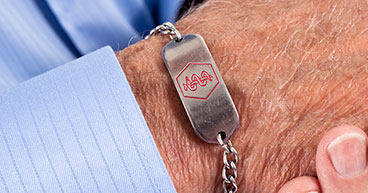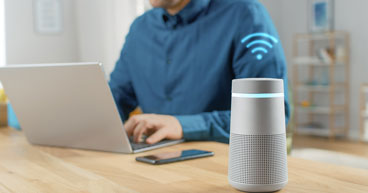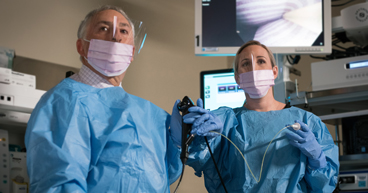
Keeping track of your health has never been easier. Wearable fitness trackers enable you to monitor your activity level, vital signs, sleep patterns and more, with little effort. Studies suggest that information captured by fitness trackers is helping people manage serious illnesses better and recover faster from treatments.
Diabetes, high blood pressure, heart disease, lung conditions like COPD and even the seasonal flu and COVID may be managed with the help of high-tech health trackers.
One study found that Fitbit® fitness trackers helped estimate how long it should take for patients to recover in the hospital, based on how active the patient was following major surgery. Another study tracked colon cancer patients undergoing chemotherapy who wore activity tracking bands connected to a mobile app on their cell phones. Again, patients who moved around more after treatment were found to have fewer emergency room visits (or other unplanned health care encounters) than cancer patients who had little or no activity.
“By leveraging technology, we are able to gather information such that at the time of a patient encounter, we already have their most recent health information,” said Virginia Sun, PhD, M.S.N., RN, professor in the Department of Population Sciences and the Department of Surgery at City of Hope® Cancer Center Duarte said in an interview with Oncology Nursing News. “Nurses can start working on the next steps in care management before they even talk to a patient.”
In this article, we’ll discuss:
- What are wearable fitness trackers?
- Wearables and cancer treatment
- Wearable devices for cancer survivors
- Selecting a wearable fitness tracker
If you’ve been diagnosed with cancer and are interested in a second opinion on your diagnosis and treatment plan, call us or chat online with a member of our team.
What are wearable fitness trackers?
Fitness trackers, like Fitbit, are designed for basic physical monitoring—step count, heart rate monitoring and sleep tracking are among the most common functions. Smartwatches, like Apple Watch® or Google Pixel® Watch, offer these functions, plus a whole host of additional health monitoring features.
Today’s smartwatches connect to your phone so you can talk and text hands-free, access virtual assistants like Siri and Google and even play music. More importantly, they connect to third-party mobile apps that capture the health data of your choice, then send your stats to cloud-based data systems. These systems analyze your numbers for patterns and offer feedback you can use to discuss with your doctor and help make personalized health care decisions.
The four most important health uses for wearable trackers are monitoring, screening, detecting and predicting. High-tech wearable trackers have the ability to:
Monitor health vitals. These may include your heart rate, blood/oxygen level and skin temperature. By monitoring health vitals, trackers can be used to identify symptom changes during treatment and help alert your care team that an adjustment to your treatment plan may be needed.
Screen daily activities related to health. These may include your sleep quality or stress level. For example, wearable trackers are often used to screen for sleep apnea.
Detect health abnormalities. Some smartwatches include electrocardiogram (ECG) capability for detecting atrial fibrillation or a glucose monitor that may help diabetic patients by detecting low blood-sugar levels.
Predict health outcomes. Studies suggest that monitoring activity levels may help predict your likelihood of being readmitted to the hospital or requiring an emergency room visit following surgery or chemotherapy treatment, or even reduce your chances of those visits.
Wearables and cancer treatment
The use of wearable fitness trackers may help cancer patients and their care teams monitor activity and other vital health information so their care plans can be adjusted more quickly and effectively. Tracking symptoms and physical activity using wearable devices may result in better symptom management, fewer emergency room visits and faster recovery from treatments.
For example, high-tech wearable devices may be used to help cancer patients and their care teams:
- Monitor vitals before and after oncology surgery
- Monitor symptoms, such as fatigue, nausea, low appetite and dehydration, which may help decrease the severity of treatment side effects
- Track and encourage physical activity, especially following cancer treatments like chemotherapy and surgery
Sun and her team at City of Hope researched the use of wearable monitors (accelerators and pedometers) in patients with cancer who underwent surgery.
“Being able to know that they have this device or they’re wearing a wristband device that is helping them track their physical activity really motivates them in terms of using that as a way to improve their post-op recovery,” Sun told Oncology Nursing News. “These kinds of wearable sensor devices can really augment what the nurses are already doing.”
Activity monitoring isn’t only important for cancer patients in treatment. Wearable fitness trackers may also be a vital tool for helping cancer survivors get back in shape and stay healthy after treatments are completed.
Wearable devices for cancer survivors
Getting enough exercise is critical for cancer survivors. Studies show it may lower cancer recurrence and reduce long-term treatment side effects.
The U.S. Centers for Disease Control and Prevention (CDC) recommends at least 150 minutes of exercise a week to support good health and reduce disease risk. That’s only 30 minutes a day, five days a week.
Despite these facts, 84 percent of cancer survivors don’t get enough exercise, according to the American Institute of Cancer Research (AICR).
If you or a loved one is having trouble getting in 30 minutes of exercise a day, you may want to consider a wearable fitness tracker. AICR found that cancer survivors who use fitness trackers report:
- More daily steps and total physical activity
- An increase in exercise intensity
- Better physical function
- Better quality of life
- Less fatigue
Wearing a fitness tracker may also encourage you to stand up and move when you sit for too long and help you stay on track by enabling you to set activity goals and alerting you when you’ve met them.
Selecting a wearable fitness tracker
Wearable fitness trackers and smartwatches come in a wide range of prices, with the most expensive offering the largest array of health monitoring features. However, if spending hundreds of dollars isn’t in your budget, or if you’re new to wearable devices, a basic fitness tracker that’s easy to use may be your best choice.
Things to consider when choosing a wearable fitness tracker:
Accuracy: Most basic fitness trackers are accurate at counting steps and monitoring heart rate. If you’re looking for more advanced functions, such as blood-oxygen saturation or GPS (to track your activity distance), a smartwatch is a better choice. Either way, be sure to research the many review articles and ratings you can find online before you buy.
Battery life: In general, fitness trackers have a longer battery life than smartwatches. Also, devices with power-hungry features like GPS and a large color display screen require more frequent charging. If sleep monitoring is important to you, it’s important to note that many smartwatches have a battery life that last only 24 hours on a full charge.
Features: Which features will you use versus ones that would be “nice to have”? Blood/oxygen level sensors are helpful because they enhance sleep monitoring. Stress and irregular heart-rate monitoring are considered essential in most of today’s fitness trackers. Some smartwatches offer exercise profiles that include workout animations showing you how to do exercises and which muscles are targeted. If swimming is part of your exercise routine, water resistance may be an important feature, but unless you scuba dive regularly, you probably don’t need a dive computer on your fitness device.
Style: Wearable fitness trackers come in a variety of materials, shapes and colors, often with replaceable bands that are more suitable for work or a dressier event. Newer models may have a high-resolution color screen, which makes it easier to read the display in bright sunlight while you’re walking, running, golfing, playing pickleball or performing other outdoor activities.
Compatibility: If you plan to use a tracker that connects to third-party health and exercise apps, be sure that it’s compatible with the brand of cellphone you already use.
Be sure to do some online research before you buy a fitness tracker or smartwatch for health monitoring. The best tracker for you is the one you’ll use consistently.
If you’ve been diagnosed with cancer and are interested in a second opinion on your diagnosis and treatment plan,call us or chat online with a member of our team.



